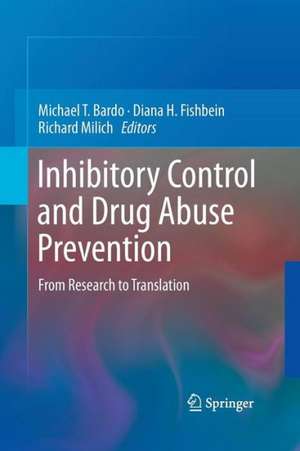Inhibitory Control and Drug Abuse Prevention: From Research to Translation
Editat de Michael T. Bardo, Diana H. Fishbein, Richard Milichen Limba Engleză Paperback – 19 aug 2014
Controlled experiments utilizing neuroscience techniques in laboratory animals or neuroimaging techniques in humans have revealed that individual differences in prefrontal cortical regions may underlie, at least in part, these differences in inhibitory control. Although a few excellent journal reviews have been published on the role of inhibitory deficits in drug abuse, there has been relatively little attention paid to the potential applications of this work for drug abuse prevention. The current book will provide both basic and applied researchers with an overview of this important health-relevant topic. Since translational research cuts across multiple disciplines and most readers are not familiar with all of these disciplines, the reading level will be geared to be accessible to graduate students, as well as to faculty and researchers in the field.
The book will be organized around three general themes, encased within introductory and concluding chapters. The first theme will review basic neurobehavioral research findings on inhibition and drug abuse. Chapters in this theme will emphasize laboratory studies using human volunteers or laboratory animals that document the latest research implicating a relation between inhibition and drug abuse at both the neural and behavioral levels of analysis. The second theme will move the topic to at-risk populations that have impulse control problems, including children, adolescents and young adults. The third theme will concentrate on prevention science as it relates to inhibitory control. Chapters in this theme will be written by experts attempting to develop and improve prevention interventions by integrating evidence-based knowledge about inhibitory control processes. In all of the chapters, writers will be asked to speculate about innovative approaches that may be useful for the practice of prevention.
| Toate formatele și edițiile | Preț | Express |
|---|---|---|
| Paperback (1) | 1097.36 lei 6-8 săpt. | |
| Springer – 19 aug 2014 | 1097.36 lei 6-8 săpt. | |
| Hardback (1) | 1102.10 lei 6-8 săpt. | |
| Springer – 5 apr 2011 | 1102.10 lei 6-8 săpt. |
Preț: 1097.36 lei
Preț vechi: 1155.11 lei
-5% Nou
Puncte Express: 1646
Preț estimativ în valută:
209.99€ • 220.24$ • 174.80£
209.99€ • 220.24$ • 174.80£
Carte tipărită la comandă
Livrare economică 01-15 aprilie
Preluare comenzi: 021 569.72.76
Specificații
ISBN-13: 9781493902248
ISBN-10: 1493902245
Pagini: 352
Ilustrații: XIV, 335 p.
Dimensiuni: 155 x 235 x 18 mm
Greutate: 0.49 kg
Ediția:2011
Editura: Springer
Colecția Springer
Locul publicării:New York, NY, United States
ISBN-10: 1493902245
Pagini: 352
Ilustrații: XIV, 335 p.
Dimensiuni: 155 x 235 x 18 mm
Greutate: 0.49 kg
Ediția:2011
Editura: Springer
Colecția Springer
Locul publicării:New York, NY, United States
Public țintă
ResearchDescriere
The purpose of this book is to review our state of knowledge about the neurobehavioral and psychosocial processes involved in behavioral inhibitory processes and to provide an insight into how these basic research findings may be translated into the practice of drug abuse prevention interventions. Over the last decade, there has been a wealth of information indicating that substance use disorders do not simply reflect an exaggeration of reward seeking behavior, but that they also represent a dysfunction of behavioral inhibitory processes that are critical in exercising self-control. A number of studies have determined that individuals with substance use disorders have poor inhibitory control compared to non-abusing individuals. In addition, the fact that the adolescent period is often characterized by a lack of inhibitory control may be one important reason for the heightened vulnerability for the initiation of drug use during this time.
Controlled experiments utilizing neuroscience techniques in laboratory animals or neuroimaging techniques in humans have revealed that individual differences in prefrontal cortical regions may underlie, at least in part, these differences in inhibitory control. Although a few excellent journal reviews have been published on the role of inhibitory deficits in drug abuse, there has been relatively little attention paid to the potential applications of this work for drug abuse prevention. The current book will provide both basic and applied researchers with an overview of this important health-relevant topic. Since translational research cuts across multiple disciplines and most readers are not familiar with all of these disciplines, the reading level will be geared to be accessible to graduate students, as well as to faculty and researchers in the field.
The book will be organized around three general themes, encased within introductory and concluding chapters. The first theme will review basic neurobehavioral research findings on inhibition and drug abuse. Chapters in this theme will emphasize laboratory studies using human volunteers or laboratory animals that document the latest research implicating a relation between inhibition and drug abuse at both the neural and behavioral levels of analysis. The second theme will move the topic to at-risk populations that have impulse control problems, including children, adolescents and young adults. The third theme will concentrate on prevention science as it relates to inhibitory control. Chapters in this theme will be written by experts attempting to develop and improve prevention interventions by integrating evidence-based knowledge about inhibitory control processes. In all of the chapters, writers will be asked to speculate about innovative approaches that may be useful for the practice of prevention.
Controlled experiments utilizing neuroscience techniques in laboratory animals or neuroimaging techniques in humans have revealed that individual differences in prefrontal cortical regions may underlie, at least in part, these differences in inhibitory control. Although a few excellent journal reviews have been published on the role of inhibitory deficits in drug abuse, there has been relatively little attention paid to the potential applications of this work for drug abuse prevention. The current book will provide both basic and applied researchers with an overview of this important health-relevant topic. Since translational research cuts across multiple disciplines and most readers are not familiar with all of these disciplines, the reading level will be geared to be accessible to graduate students, as well as to faculty and researchers in the field.
The book will be organized around three general themes, encased within introductory and concluding chapters. The first theme will review basic neurobehavioral research findings on inhibition and drug abuse. Chapters in this theme will emphasize laboratory studies using human volunteers or laboratory animals that document the latest research implicating a relation between inhibition and drug abuse at both the neural and behavioral levels of analysis. The second theme will move the topic to at-risk populations that have impulse control problems, including children, adolescents and young adults. The third theme will concentrate on prevention science as it relates to inhibitory control. Chapters in this theme will be written by experts attempting to develop and improve prevention interventions by integrating evidence-based knowledge about inhibitory control processes. In all of the chapters, writers will be asked to speculate about innovative approaches that may be useful for the practice of prevention.
Cuprins
I. Introduction.- Benefits of a translating research on inhibitory control for the prevention drug abuse.- II. Neurobehavioral Approaches for Understanding Inhibitory Control.- Animal models of inhibitory control.- Neurochemical influences on impulsivity and cognitive control in laboratory animals.- Genetic determinants of behavior and impulse control in alcoholic families.- Impaired inhibitory control as a mechanism in drug addiction.- Neuroimaging, adolescence, and risky behavior.- III. Translating Research on Inhibitory Control to At-Risk Populations.- Inhibitory control deficits in childhood and risk for substance use.- Translating basic science research findings into applications for prevention.- Impulsivity and adolescent substance use.- Positive and negative reinforcement processes underlying adolescent risk taking.- Developmental changes in neurocircuitry underlying impulse control and addiction vulnerability in adolescence.- Neurobehavioral disinhibition, brain activation, and risk for substance abuse.- IV. Translating Research on Inhibitory Control to Prevention Interventions.- Effects of adversity on development of inhibitory control and the role of parental involvement on prevention of adverse .- Preventing early conduct problems through a targeted intervention to strengthen inhibitory control and emotional regulation.- Developmental psychopathology: Focusing on core inhibitory competencies to prevent substance abuse.- Designing public service announcements that target impulsive or sensation-seeking adolescents to prevent drug abuse.- Preventive interventions designed to target underlying emotional regulatory mechanisms in high risk behaviors.- V. Conclusion.- Policy issues and advocacy translating research on inhibitory control to drug abuse prevention.- Final thoughts on inhibition and drug abuse: Where do we go from here?
Recenzii
From the reviews:
“This book explores behavioral inhibition and multiple factors that affect its development and deficiencies with the goal of reducing risk-taking behavior and impulsivity … . ‘general overview of the current knowledge base regarding behavioral inhibition and its etiology, from genetic and neurobiological underpinnings to social factors that influence its development’ … . The book is intended for a board audience of researchers, practitioners, policy scientists and makers, and trainees … . Numerous tables and figures clarify the text, and this book is easy to read.” (Gary B. Kaniuk, Doody’s Review Service, July, 2011)
“This book explores behavioral inhibition and multiple factors that affect its development and deficiencies with the goal of reducing risk-taking behavior and impulsivity … . ‘general overview of the current knowledge base regarding behavioral inhibition and its etiology, from genetic and neurobiological underpinnings to social factors that influence its development’ … . The book is intended for a board audience of researchers, practitioners, policy scientists and makers, and trainees … . Numerous tables and figures clarify the text, and this book is easy to read.” (Gary B. Kaniuk, Doody’s Review Service, July, 2011)
Notă biografică
Michael Bardo, Ph.D. is professor of psychology and director of the NIDA-funded Center for Drug Abuse Research Translation (CDART) at the University of Kentucky. He currently teaches at both the undergraduate and graduate levels, and maintains a research laboratory investigating the biological bases of drug abuse. His laboratory is primarily interested in understanding the basic neuropharmacological mechanisms that underlie drug abuse vulnerability using laboratory animals. He is a fellow of the Association for Psychological Science and a member of the Society for Neuroscience, American Psychological Association Division 28, Midwestern Psychological Association, Society for Prevention Research, New York Academy of Sciences, and is active on the editorial board of numerous pharmacology, neuroscience, and psychology journals.
Diana Fishbein, Ph.D. is Senior Fellow in behavioral neuroscience and directs the Transdisciplinary Behavioral Science Program at RTI. She began her career as professor of criminology at the University of Baltimore and as a scientific investigator at the University of Maryland Medical School and subsequently the National Institute on Drug Abuse, the Department of Justice, and the University of Maryland HIDTA Program. Dr. Fishbein consults with federal, state, and local agencies for purposes of expert witnessing in criminal court, training, technical assistance, scientific peer reviews, and development of research protocols. She publishes regularly in her field and is primary author of two textbooks, The Dynamics of Drug Abuse and Biobehavioral Perspectives in Criminology, and editor of two volumes of The Science, Treatment, and Prevention of Antisocial Behavior.
Richard Milich, Ph.D. is a professor of psychology and administrative director of the Center for Drug Abuse Research Translation (CDART) at the University of Kentucky. His primary research interests are childhood behavior problems (especially attention deficit hyperactivity disorder and conduct disorder) and predictors of long-term drug use. He is administrative director of the university’s NHIDA funded Drug Prevention Center. His primary clinical interests are in the area of disordered child behavior. He received the 2007 Kentucky Psychological Association Outstanding Mentor Award, the 2004 William Sturgill Award from the University of Kentucky, and the Division 53 of APA award for outstanding graduate student mentoring. He is a Fellow of APA Divisions 12 and 53. He is active on the editorial boards of several journals, including Journal of Abnormal Child Psychology, Journal of Abnormal Psychology, Journal of Consulting and clinical Psychology, Journal of Attention Disorders, and Perspectives on Psychological Science.
Diana Fishbein, Ph.D. is Senior Fellow in behavioral neuroscience and directs the Transdisciplinary Behavioral Science Program at RTI. She began her career as professor of criminology at the University of Baltimore and as a scientific investigator at the University of Maryland Medical School and subsequently the National Institute on Drug Abuse, the Department of Justice, and the University of Maryland HIDTA Program. Dr. Fishbein consults with federal, state, and local agencies for purposes of expert witnessing in criminal court, training, technical assistance, scientific peer reviews, and development of research protocols. She publishes regularly in her field and is primary author of two textbooks, The Dynamics of Drug Abuse and Biobehavioral Perspectives in Criminology, and editor of two volumes of The Science, Treatment, and Prevention of Antisocial Behavior.
Richard Milich, Ph.D. is a professor of psychology and administrative director of the Center for Drug Abuse Research Translation (CDART) at the University of Kentucky. His primary research interests are childhood behavior problems (especially attention deficit hyperactivity disorder and conduct disorder) and predictors of long-term drug use. He is administrative director of the university’s NHIDA funded Drug Prevention Center. His primary clinical interests are in the area of disordered child behavior. He received the 2007 Kentucky Psychological Association Outstanding Mentor Award, the 2004 William Sturgill Award from the University of Kentucky, and the Division 53 of APA award for outstanding graduate student mentoring. He is a Fellow of APA Divisions 12 and 53. He is active on the editorial boards of several journals, including Journal of Abnormal Child Psychology, Journal of Abnormal Psychology, Journal of Consulting and clinical Psychology, Journal of Attention Disorders, and Perspectives on Psychological Science.
Textul de pe ultima copertă
Inhibitory Control and Drug Abuse PreventionFrom Research to TranslationMichael T. Bardo, Diana H. Fishbein, Richard Milich, editorsSome of the most promising findings about drug abuse come from research into behavioral inhibitory control processes—specifically, that individuals with substance use disorders have inhibitory control deficiencies compared to non-abusers, and that the impulsivity associated with adolescence may account for young people’s vulnerability toward drug-taking behavior. But while this neurobiological approach has steadily influenced the treatment of addiction, it has had only minor effect on prevention efforts.Inhibitory Control and Drug Abuse Prevention was compiled to help correct this situation, synthesizing what we know about the neuromechanics of risk-taking, and mining its ample potential in addiction prevention. Noted experts review up-to-date neurobehavioral studies regarding inhibitory control in humans and laboratory animals, discuss their implications for age groups at risk for impulse control deficits or dysfunction, and apply these findings to the development of innovative, effective prevention strategies. Among the topics covered in this multidisciplinary volume: •Genetic and environmental determinants of risk-taking behavior.•Impaired inhibitory control as a mechanism in drug abuse.•Childhood inhibitory control deficits and risk for substance use.•Social influence in inhibitory control.•Translating research into advocacy and policy.•Targeting anti-drug public service messages to sensation-seeking youth. Inhibitory Control and Drug Abuse Prevention represents a sea change in understanding addictive behavior, and is timely reading for researchers and practitioners in the fields of drug abuse (as well as related high-risk behaviors, e.g., delinquency, unsafe sex, gambling), health psychology, and neuropsychology.
Caracteristici
On the cutting edge of neurobiology and drug abuse prevention
Puts emphasis on the translation of basic neurobiological science into drug abuse prevention
Worked with major granting agencies (most notably the National Institutes of Health)
Includes supplementary material: sn.pub/extras
Puts emphasis on the translation of basic neurobiological science into drug abuse prevention
Worked with major granting agencies (most notably the National Institutes of Health)
Includes supplementary material: sn.pub/extras














